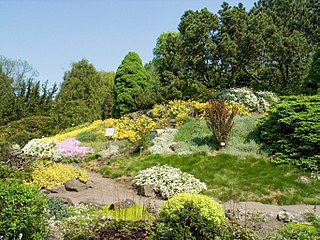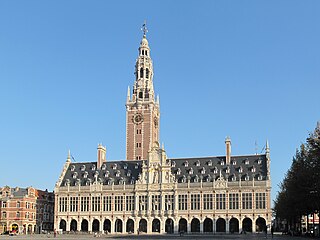

The Hortus Botanicus Lovaniensis (Dutch: Kruidtuin) is a botanical garden in Leuven, Belgium, dating from 1738. It is situated in the city centre and has an extent of 2.2 hectares.


The Hortus Botanicus Lovaniensis (Dutch: Kruidtuin) is a botanical garden in Leuven, Belgium, dating from 1738. It is situated in the city centre and has an extent of 2.2 hectares.
A first botanical garden was established in Leuven in 1738 by Henri-Joseph Rega, Professor of Medicine at the University of Leuven. [1] Its first aim was to provide herbs for medical use. Later, the gardens became used for study purposes and they hosted an extensive collection of ornamental plants, cultivated plants with economic potential, and rare plants.
When the university was closed in 1797, the botanical garden was seized by the state. A botanical garden was re-established in the 1820s, adjacent to the original garden, under the auspices of the new State University of Leuven. When the State University closed in 1835, ownership of the new botanical garden was transferred to the city authorities. In 1874, a girls' school was built over the original site of the 1738 botanical garden, but the newer garden established in the 1820s continues in use as a municipal park. [1] Access is free and it is used extensively by tourists and citizens alike. The garden functions sometimes as a place of exhibition for contemporary art.

A botanical garden or botanic garden is a garden with a documented collection of living plants for the purpose of scientific research, conservation, display, and education. It is their mandate as a botanical garden that plants are labelled with their botanical names. It may contain specialist plant collections such as cacti and other succulent plants, herb gardens, plants from particular parts of the world, and so on; there may be glasshouses or shadehouses, again with special collections such as tropical plants, alpine plants, or other exotic plants that are not native to that region.

An arboretum is a botanical collection composed exclusively of trees and shrubs of a variety of species. Originally mostly created as a section in a larger garden or park for specimens of mostly non-local species, many modern arboreta are in botanical gardens as living collections of woody plants and are intended at least in part for scientific study.

The New York Botanical Garden (NYBG) is a botanical garden at Bronx Park in the Bronx, New York City. Established in 1891, it is located on a 250-acre (100 ha) site that contains a landscape with over one million living plants; the Enid A. Haupt Conservatory, a greenhouse containing several habitats; and the LuEsther T. Mertz Library, which contains one of the world's largest collections of botany-related texts. As of 2016, over a million people visit the New York Botanical Garden annually.

The City Botanic Gardens is a heritage-listed botanic garden on Alice Street, Brisbane City, City of Brisbane, Queensland, Australia. It was also known as Queen's Park. It is located on Gardens Point in the Brisbane CBD and is bordered by the Brisbane River, Alice Street, George Street, Parliament House and Queensland University of Technology's Gardens Point campus. It was established in 1825 as a farm for the Moreton Bay penal settlement.

The Hortus botanicus of Leiden is the oldest botanical garden of the Netherlands, and one of the oldest in the world. It is located in the southwestern part of the historical centre of the city, between the Academy building and the old Leiden Observatory building.

The Meise Botanic Garden, until 2014 called the National Botanic Garden of Belgium, is a botanical garden located in the grounds of Bouchout Castle in Meise, Flemish Brabant, just north of Brussels. It is one of the world's largest botanical gardens, with an extensive collection of living plants and a herbarium of about 4 million specimens. The current garden was established in 1958 after moving from central Brussels; the former site is now the Botanical Garden of Brussels.

The Bogor Botanical Gardens is a botanical garden located in Bogor, Indonesia, 60 km south of central Jakarta. It is currently operated by the National Research and Innovation Agency. The garden is located in the city center and adjoin the presidential palace compound of Istana Bogor. It covers an area of 87 hectares and contains 13,983 different kinds of trees and plants of various origin. The geographic position of Bogor means it rains almost daily, even in the dry season. This makes the garden an advantageous location for the cultivation of tropical plants.

Ulmus 'Homestead' is an American hybrid elm cultivar raised by Alden Townsend of the United States National Arboretum at the Nursery Crops Laboratory in Delaware, Ohio. The cultivar arose from a 1970 crossing of the Siberian Elm Ulmus pumila with the hybrid N 215, the latter grown from seed sent in 1960 to the University of Wisconsin-Madison elm breeding team by Hans Heybroek of the De Dorschkamp Research Institute in the Netherlands. Tested in the US National Elm Trial coordinated by Colorado State University, 'Homestead' averaged a survival rate of 85% after 10 years in the US National Elm Trial. However, planting of the tree was not recommended, owing principally to its 'ugly' shape and susceptibility to Southwest injury. 'Homestead' was released to commerce without patent restrictions in 1984.

The Botanic Garden of the Jagiellonian University is a botanical garden, founded in 1783 in Kraków. It is located east of the Old Town and occupies 9.6 hectares. It belongs to the Jagiellonian University and is classified as a historical location.

Botanique (French) or Kruidtuin (Dutch) is a Brussels Metro station on the northern segment of lines 2 and 6. It is located under the Small Ring at the Rue Royale/Koningsstraat in the municipality of the Saint-Josse-ten-Noode, north of the City of Brussels, Belgium. It opened as a premetro station on 18 August 1974 and became a full metro station on 2 October 1988.

The Botanischer Garten Gießen, more formally the Botanischer Garten der Justus-Liebig-Universität Gießen, is a historic botanical garden maintained by the University of Giessen. It is the oldest botanical garden in Germany still at its original site, with an entrance at Senckenbergstraße 6, Gießen, Hesse, Germany. It is open daily without charge.

The city of Leuven in Belgium was the seat of three successive universities, each of which had a notable academic library.

The Wüstenhaus Schönbrunn is a desert botanical exhibit in Vienna, Austria. It is located in the Sonnenuhrhaus, which was built in 1904 as the newest of the four botanical houses in Schönbrunn Palace Park. The desert exhibit opened in 2004 as a counterpart to the "Rainforest House" that opened in 2002 in the nearby Vienna Zoo.

The Botanical Garden of Brussels is a former botanical garden in Brussels, Belgium. It was created in 1826 and stood on the Rue Royale/Koningsstraat in Saint-Josse-ten-Noode, near Brussels' Northern Quarter financial district, until its relocation in 1938 to the National Botanic Garden of Belgium in Meise, Flemish Brabant.

The Natural History Museum Denmark is a natural history museum located in Copenhagen, Denmark. It is affiliated with the University of Copenhagen
The following is a timeline of the history of the municipality of Leuven, Belgium.

The Botanic Garden of Antwerp, which also carries the name Den Botaniek, is a landscaped botanical garden created in 1825 in the inner city of Antwerp located at the Leopoldstraat, covering an area of slightly less than 1 hectare. Before that the park was, at the end of the 18th century, a plant garden for the Ecole Centrale and then the herb garden and later the vegetable garden of the Sint-Elisabethgasthuis in Antwerp.

The Botanical Garden of Mechelen is the largest public park within the historic city centre of Mechelen, Belgium. It is located on the north bank of the River Dijle and is surrounded by educational establishments. Entrances are in the Bruul, the Pitzemburgstraat, and via a footpath from the Zandpoortvest.
Henri-Joseph Rega (1690–1754) was a professor of medicine and rector of Leuven University, in the Habsburg Netherlands, where he established a botanical garden, laboratories for chemistry and physics, and an anatomical theatre, as well as adding a new wing to the University Hall.

The University Hall in Leuven, Belgium, is a medieval cloth hall with 17th and 18th-century extensions that is now the main administrative building of the KU Leuven. Heavily damaged during the Sack of Leuven in August 1914, the building was restored 1921–1926. It has been a listed building since 26 November 1942, and protected built heritage since 14 September 2009. The building fills most of a block, with entrances on three of the surrounding streets at Krakenstraat 2, Naamsestraat 22, and Oude Markt 13.
50°52′40″N4°41′24″E / 50.8779°N 4.6901°E